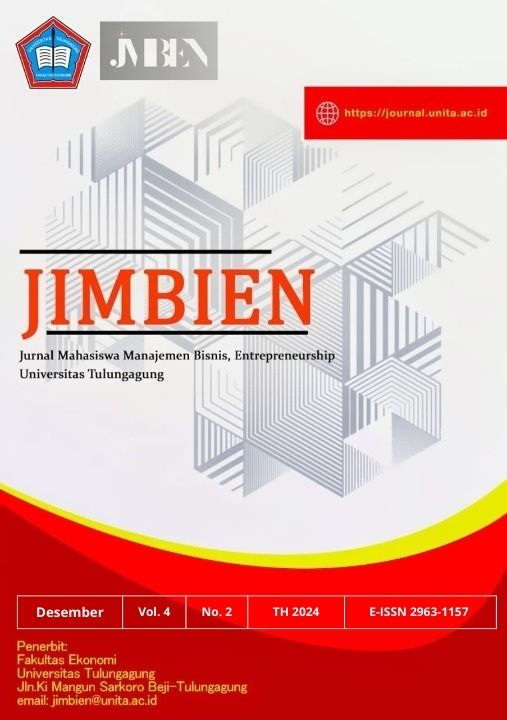SHOPEEPAYLATER DAN GAYA HIDUP: PENGARUHNYA TERHADAP KONSUMSI BERLEBIHAN DI KALANGAN MAHASISWA EKONOMI UNIVERSITAS TULUNGAGUNG
DOI:
https://doi.org/10.36563/jimbien.v3i2.1365Keywords:
Gaya hidup, Shopee PayLater, perilaku konsumtif, mahasiswa, e-commerceAbstract
Penelitian ini bertujuan untuk menganalisis pengaruh gaya hidup (lifestyle) dan fitur Shopee PayLater terhadap perilaku konsumtif mahasiswa Fakultas Ekonomi Universitas Tulungagung. Pendekatan kuantitatif digunakan dengan pengumpulan data melalui kuesioner daring kepada 56 responden. Hasil penelitian menunjukkan bahwa gaya hidup (lifestyle) berpengaruh signifikan terhadap perilaku konsumtif mahasiswa, dengan nilai t-hitung sebesar 2,703 > t-tabel 2,006 dan signifikansi 0,009. Fitur Shopee PayLater juga memiliki pengaruh signifikan, dengan nilai t-hitung sebesar 3,458 > t-tabel 2,006 dan signifikansi 0,001. Secara simultan, kedua variabel ini memberikan pengaruh signifikan, dengan nilai F-hitung sebesar 39,141 > F-tabel 3,172 dan signifikansi 0,000. Kesimpulan dari penelitian ini adalah gaya hidup konsumtif dan kemudahan kredit digital dari Shopee PayLater mendorong perilaku konsumtif mahasiswa, yang dapat berdampak negatif terhadap kondisi finansial mereka. Diperlukan edukasi tentang manajemen keuangan untuk mengurangi risiko perilaku konsumtif yang berlebihan.
Downloads
References
Ajzen, I. (1991). The Theory of Planned Behavior. Organizational Behavior and Human Decision Processes, 50(2), 179–211.
Chaffey, D., & Smith, P. R. (2017). Digital Marketing Excellence: Planning, Optimizing, and Integrating Online Marketing. Routledge.
Chen, L., Zhang, D., & Zhou, L. (2021). Effects of PayLater Systems on Consumer Behavior. Journal of Consumer Research, 48(2), 345–363.
Chiu, C. M., Chang, C. C., Cheng, H. L., & Fang, Y. H. (2009). Determinants of Customer Repurchase Intention in Online Shopping. Online Information Review, 33(4), 761–784.
Cooper, D. R., & Schindler, P. S. (2014). Business Research Methods (12th ed.). McGraw-Hill Education.
Creswell, J. W. (2014). Research Design: Qualitative, Quantitative, and Mixed Methods Approaches (4th ed.). SAGE Publications.
Ghozali, I. (2016). Aplikasi Analisis Multivariate dengan Program IBM SPSS 23. Semarang: Universitas Diponegoro.
Hair, J. F., Black, W. C., Babin, B. J., & Anderson, R. E. (2010). Multivariate Data Analysis (7th ed.). Pearson.
Holbrook, M. B., & Hirschman, E. C. (1982). The Experiential Aspects of Consumption: Consumer Fantasies, Feelings, and Fun. Journal of Consumer Research, 9(2), 132–140.
Kartika, R., Raharjo, S., & Mulyono, H. (2021). Gaya Hidup Digital dan Konsumtivisme Mahasiswa. Jurnal Manajemen dan Bisnis, 25(3), 167–178.
Kothari, C. R. (2004). Research Methodology: Methods and Techniques (2nd ed.). New Age International Publishers.
Kotler, P., & Keller, K. L. (2016). Marketing Management (15th ed.). Pearson.
Laudon, K. C., & Traver, C. G. (2020). E-commerce 2020: Business, Technology, Society (16th ed.). Pearson.
Lina, L., & Rosyid, F. (2018). Pengaruh Gaya Hidup terhadap Perilaku Konsumtif Mahasiswa. Jurnal Ekonomi dan Bisnis, 17(2), 112-121.
Malhotra, N. K. (2019). Marketing Research: An Applied Orientation (7th ed.). Pearson.
Nguyen, T., Pham, H., & Le, T. (2021). Digital Payment Systems and Consumer Behavior. Asia-Pacific Journal of Business, 10(3), 122–139.
Pallant, J. (2020). SPSS Survival Manual: A Step by Step Guide to Data Analysis Using IBM SPSS (7th ed.). Routledge.
Pavlou, P. A. (2003). Consumer Acceptance of Electronic Commerce: Integrating Trust and Risk with the Technology Acceptance Model. International Journal of Electronic Commerce, 7(3), 101–134.
Prawira, M. A., Wardhana, S., & Nugroho, B. (2022). The Impact of E-Wallet on College Students’ Spending Behavior. Jurnal Ekonomi Digital, 19(4), 145–159.
Rachmawati, R., & Irawan, R. (2020). Pengaruh ShopeePayLater terhadap Gaya Hidup Konsumtif. Jurnal Ilmu Sosial dan Humaniora, 24(3), 175-185.
Sekaran, U., & Bougie, R. (2016). Research Methods for Business: A Skill Building Approach (7th ed.). Wiley.
Solomon, M. R. (2017). Consumer Behavior: Buying, Having, and Being (12th ed.). Pearson.
Statista. (2023). Indonesia e-commerce market report. Retrieved from https://www.statista.com
Sugiyono. (2019). Metode Penelitian Kuantitatif, Kualitatif, dan R&D. Bandung: Alfabeta.
Thaler, R. H. (1985). Mental Accounting and Consumer Choice. Marketing Science, 4(3), 199–214.
Wang, H., & Lee, J. Y. (2022). PayLater Adoption and Financial Wellbeing Among College Students. Journal of Financial Behavior, 28(1), 45–62.
Wong, J., Kwok, W., & Yeung, C. (2020). Cashless Payments and Impulse Buying: Evidence from Emerging Markets. Global Journal of Economics and Business, 11(3), 87–101.
Yulianti, K., & Silviana, S. (2021). Dampak Teknologi Digital pada Perilaku Konsumtif Mahasiswa. Jurnal Manajemen Teknologi, 20(1), 55-63.
Zhou, X., & Li, Y. (2021). Digital Lifestyles and Spending Patterns: Insights from Generation Z. Journal of Digital Marketing, 35(2), 98–114.
Downloads
Published
Issue
Section
Deprecated: json_decode(): Passing null to parameter #1 ($json) of type string is deprecated in /home/journal.unita.ac.id/public_html/plugins/generic/citations/CitationsPlugin.php on line 68






